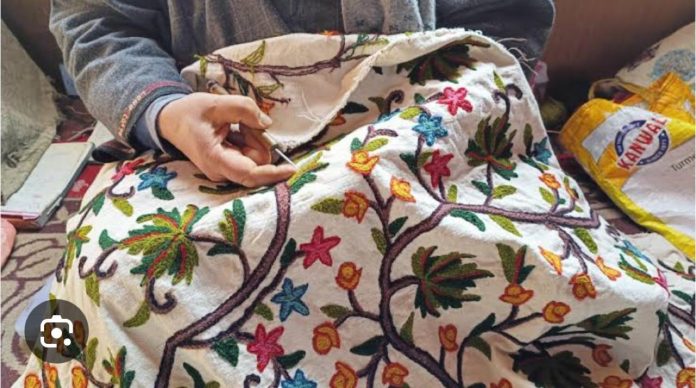Vishwakarma scheme can transform JK’s cultural industry
Street Talk
Expert Opinion

([email protected])
Do you know? Craft sector is estimated to be the second largest employer after agriculture in rural India. Overall, the estimates peg the number of artisans in the country at over 200 million. Despite being one of the largest producers of handmade arts and crafts in the world, India has not been able to capture substantial market share at global level. Reason is simple.
The crafts sector continues to be an informal segment of the economy and the artisans always remain starved of sufficient money to explore their potential as their skill is not guaranteeing them the wages which they deserve. Besides, the products carved out by them lack marketing support on modern lines. Whatever exports are done in the handicrafts, which is estimated as $4.5 billion, is handled by traders and the artisans are denied their right to access to the markets. A close look at the sector’s current supply chain structure, the inequalities are visible.
According to close watchers who have an eye on the plight of artisans in the country, at the higher end of the retail segment, top designers and labels have huge margins, with actual makers of products getting peanuts. In the given scenario, the artisan community is witnessing dwindling numbers as the craftsmen are forced to take to some other occupation which they believe can fetch them sufficient money to fund their domestic budgets and stay financially afloat.
In the local (Jammu & Kashmir) context, the scenario around the artisan community is pitiable. Even as tourism is considered the backbone of the region’s economy and key zone of employment, the handicrafts sector is the spinal cord of this backbone. Our arts and crafts industry is identified as our cultural industry. Remarkably, as per estimates, this economically powerful cultural industry is an umbrella to over 6 lakh people who directly carve out living out of their skillful craftsmanship.
Globally, our craftsmen have been hailed for making our handicrafts a prized possession. Their skillful craftsmanship has captured the hearts of millions of people. But there is a painful scenario which is loaded with some stunning shades of life of our artisan community. Their own hearts have been bleeding. Their craftsmanship has failed them to prosper as growing miseries have been taxing them. They have not grown to a size (standard of living) which could have motivated them to entirely bank on their skill to carve out their livelihood.
Reason is lack of financial resources as well as a dingy working environment. The flow of money from the formal system has not been smooth for them. In the name of financial support, the influential hijack the craft of these artisans for peanuts. In olden days, exporters and middlemen used to fleece the artisans by giving them small loans and in exchange taking their crafts at a very marginal price. They used to sell these pieces of art to the outside world at lucrative prices. Thus, there was a yearning gap between the people who used to produce it and those who used to sell it.
Today this situation has not changed much. Artisans continue to be in a dilemma for lack of proper financial resources. However, there is a ray of hope now for these artisans who have been struggling for want of sufficient finance to carry out their skillful craftsmanship. Remarkably, on the eve of 77th Independence Day, the Prime Minister Narendra Modi announced a special scheme, “PM Vishwakarma”, for traditional craftspeople and artisans for five financial years from 2023-2024 to 2027-2028. In a swift action, the Cabinet Committee on Economic Affairs (CCEA) on August 16 approved the scheme with an outlay of Rs.13,000 crore. This is considered to be a shot in the arm of the craft sector as the scheme has the potential to bring artisan community into the formal financial system and help them to get rid of informal financing. Besides, the scheme focuses on improving the skills and craftsmanship of the artisans which would be backed by the certification vetting their professional capabilities.
What is the exact nature of the PM Vishwakarma Scheme?
It’s a loan scheme designed to support individuals with skillful craftsmanship in traditional crafts. The beauty of the scheme is that it will be covering traditional trades. Initially, the scheme will encompass 18 traditional trades, fostering the preservation of the “Guru-Shishya Parampara” or family-based practice of traditional skills among artisans and craftsmen who rely on hands-on work.
The scheme is targeted at craftspeople including carpenters, boat makers, armourers, blacksmiths, hammer and tool kit makers, locksmiths, goldsmiths, potters, sculptors, stone breakers, cobblers/shoe smiths /footwear artisans, mason basket/ mat/broom makers/coir weavers, traditional doll & toy makers, barbers, garland makes, washermen, tailors, and fishing net makers.
There is scope of recognition as well as certification of the artisans. The scheme envisages that artisans and craftsmen will gain recognition through the issuance of the PM Vishwakarma certificate and ID card, contributing to their professional identity.
It offers opportunities for skill enhancement, incentivizes toolkits, promotes digital transactions, and extends marketing support.
As per the scheme structure, the aim is also to improve the quality and global reach of products and services crafted by artisans and craftsmen. It emphasizes their integration within domestic and global value chains.
Remarkably, there is no age restriction specified for applying to the scheme.
What is the extent of financial support in terms of loan?
The artisans would get collateral free ‘Enterprise Development Loans’ of upto Rs. 3 lakh in two tranches of Rs. 1 lakh and Rs. 2 lakh with tenures of 18 months and 30 months, respectively, at a concessional rate of interest fixed at 5%, with Government of India subvention to the extent of 8%. Beneficiaries who have completed basic training will be eligible to avail the first tranche of credit support of upto Rs. 1 lakh. The second loan tranche will be available to beneficiaries who have availed the first tranche and maintained a standard loan account and have adopted digital transactions in their business or have undergone advanced training.
The scheme among other things includes a skill enhancement programme where participants would be entitled to a stipend of Rs 500 per day during their training period. Even there would be financial support to procure modern tools required for enhancing efficiency and productivity.
There is also an incentive for digital transactions. An amount of one rupee per eligible digital transaction, upto maximum 100 eligible transactions monthly will be provided to the beneficiary for digital pay-out or receipt.
Besides, the scheme envisages marketing support to the artisans/craftsmen in the form of quality certification, branding, on boarding on e-commerce platforms such as GeM, advertising, publicity and other marketing activities to improve linkage to value chain.
Notably, the scheme has been tailored for both urban and rural areas, with a target of facilitating employment opportunities for around 15,000 citizens annually. It would be integrating artisans into the MSME sector, enhancing their visibility and access to resources. The scheme would be serving as an encouragement for others to engage in traditional crafts. It’s hoped that the scheme will go a long way to improve the standard of living of the craftsmen.
Does this mean, the scheme is going to be a game changer for artisans/craftsmen?
The scheme is going to be a shot in the arm of artisans as they would be seeking working capital and access to the formal financial system through this initiative. Precisely, this is a good move and takes care of a known need – the financial support in terms of working capital etc.
Since the scheme aims to strengthen and nurture the “Guru-Shishya Parampara” or the family-based practice of traditional skills by artisans and craftspeople working with their hands and tools, it’s imperative that senior ‘ustaads’ (Gurus) are also included in training programmes. They should be trained in modern skills, tools and methods so that standardization of trade skills can be achieved.
Experts are of the view that their role as trainers should also be formally recognised and incentivised so they can train and skill more apprentices beyond their own immediate family/need. Of course, the key features give a hope that the scheme would be a game changer in the lives of the craftsmen, there is, however, dire need to lay more emphasis on the marketing of the products in domestic as well as global markets in a more organized way.


